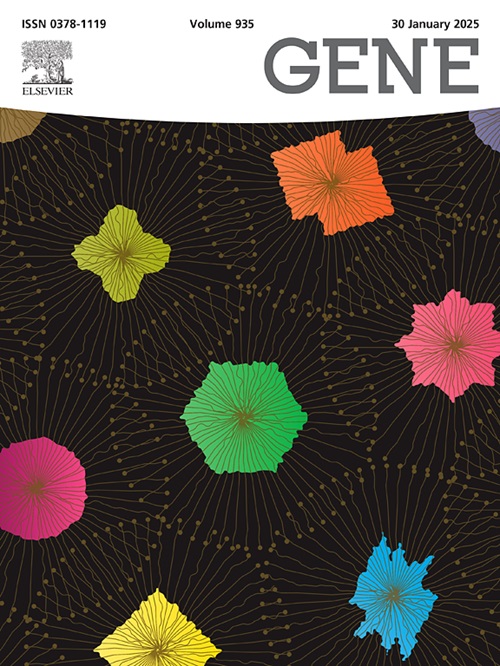肺急性呼吸窘迫综合征基底细胞的单核RNA测序和分析。
IF 2.4
3区 生物学
Q2 GENETICS & HEREDITY
引用次数: 0
摘要
目的:通过单细胞水平分析,寻找肺急性呼吸窘迫综合征(acute respiratory distress syndrome, ARDSp)患者基底细胞特异性基因表达谱。方法:18例ARDSp受试者和7例健康受试者肺样本的单核RNA测序(snRNA-seq)数据来源于GEO数据库(GSE171524)。差异表达基因(DEGs)通过|、log2FC、|、|筛选,P < 0.05。通过基因本体(Gene Ontology, GO)分析构建功能富集。通过京都基因与基因组百科全书(KEGG)分析进行途径富集。deg的蛋白-蛋白相互作用(PPI)网络通过STRING数据库进行。使用Cytoscape软件寻找枢纽基因。构建ARDSp大鼠模型后,对中心基因进行测序并通过数据集进行验证。结果:使用DESeq2包,在ARDSp参与者中发现299个基因下调,228个基因上调。氧化石墨烯分析显示,DEGs在肌动蛋白丝组织、小gtpase介导的信号转导调节、对未折叠蛋白的反应、伤口愈合和对氧水平的反应等过程中富集。同时,KEGG分析显示,DEGs参与蛋白质消化吸收、Th17细胞分化、铁死亡等生物学效应。10个枢纽基因,包括FN1、HIF1A、HSP90AA1、SMAD3、FOS、CDKN2A、COL1A1、HSPA8、FLNA和NFKBIA,基于它们的网络中心性和生物学意义被突出显示。HIF1A、HSPA8、NFKBIA和CDKN2A在验证数据集中存在差异表达。结论:ARDSp基底细胞的基因表达发生了显著变化,共鉴定出10个枢纽基因。其中4个(HIF1A、HSPA8、NFKBIA、CDKN2A)通过ARDSp大鼠模型的RNA-Seq数据进行了实验验证。本研究强调了基底细胞在ARDSp中的作用,强调了参与修复和炎症反应的基因网络的改变,为进一步的治疗探索提供了潜在的靶点。这些发现表明,这些中心基因的改变可能对ARDSp中基底细胞驱动的炎症和修复反应至关重要。本文章由计算机程序翻译,如有差异,请以英文原文为准。
Single nuclear RNA sequencing and analysis of basal cells in pulmonary acute respiratory distress syndrome
Objective
This study aims to find the gene expression profile specifically in basal cells from pulmonary acute respiratory distress syndrome (ARDSp) patients using single-cell level analysis.
Methods
Single nuclear RNA sequencing (snRNA-seq) data of lung samples, including 18 ARDSp participants and 7 healthy participants, were sourced from the GEO database (GSE171524). The differentially expressed genes (DEGs) were screened by | log2FC | >1 and P < 0.05. Functional enrichment was constructed via Gene Ontology (GO) analysis. Pathway enrichment was conducted via Kyoto Encyclopedia of Genes and Genomes (KEGG) analysis. The protein–protein interaction (PPI) network of the DEGs was performed via the STRING database. Cytoscape software was employed to find hub genes. The hub genes were sequenced and validated via data set after constructing the rat model of ARDSp.
Results
Using DESeq2 package, 299 genes were disclosed to be downregulated, while 228 were upregulated in ARDSp participants. GO analysis disclosed DEGs were enriched in processes like actin filament organization, regulation of small GTPase-mediated signal transduction, response to unfolded protein, wound healing, and response to oxygen levels. Meanwhile, KEGG analysis disclosed DEGs were involved in protein digestion and absorption, Th17 cell differentiation, iron death, and other biological effects. Ten hub genes, including FN1, HIF1A, HSP90AA1, SMAD3, FOS, CDKN2A, COL1A1, HSPA8, FLNA, and NFKBIA were highlighted based on their network centrality and biological significance. HIF1A, HSPA8, NFKBIA, and CDKN2A were differentially expressed in the validation dataset.
Conclusions
Basal cells in ARDSp exhibit significant changes in gene expression, with ten hub genes identified. Among them, four (HIF1A, HSPA8, NFKBIA, CDKN2A) were validated experimentally using RNA-Seq data from an ARDSp rat model. This study emphasizes the role of basal cells in ARDSp, highlighting the altered gene networks involved in repair and inflammatory responses, providing potential targets for further therapeutic exploration. These findings suggest that alterations in these hub genes may be crucial to basal cell-driven inflammatory and reparative responses in ARDSp.
求助全文
通过发布文献求助,成功后即可免费获取论文全文。
去求助
来源期刊

Gene
生物-遗传学
CiteScore
6.10
自引率
2.90%
发文量
718
审稿时长
42 days
期刊介绍:
Gene publishes papers that focus on the regulation, expression, function and evolution of genes in all biological contexts, including all prokaryotic and eukaryotic organisms, as well as viruses.
 求助内容:
求助内容: 应助结果提醒方式:
应助结果提醒方式:


